

|
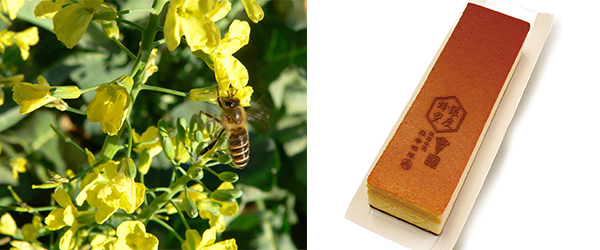 |
 News & Announcements |
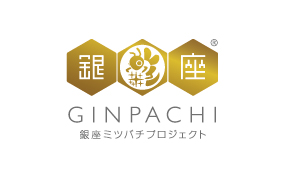 Special Article "Bee a Locavore While in Tokyo" Ginza Honey Project |
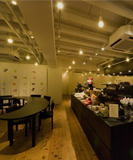 Tokyo's Concept Cafe |
| Event Information |
| Updated Radiation-related Information in Tokyo |
| News & Announcements |
| Japan’s First Transit Hotel "ROYAL PARK HOTEL THE HANEDA, TOKYO" |
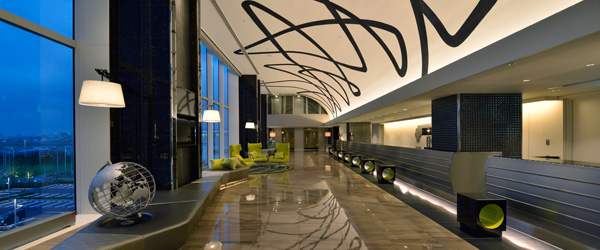
|
With the recent increase in the number of flights from overseas, Haneda Airport International Terminal Building has been improving its functions and facilities. Located within the terminal building, the hotel has a total of 313 guest rooms from the 2nd to 8th floors. Among the guest rooms, 17 are located within the departure area, serving as transit hotel rooms. The "Restaurant & Bar" is open from 5 a.m. to 1 a.m. to serve early-morning fliers and late-night arrivals. The facility also has refresh rooms in both areas that offer a shower room and a space to relax for visitors to the airport (2,000 yen (18.35 USD) per 1 hour at the general area, 3,000 yen (27.52USD) per 1 hour at the transit area). The hotel has started accepting reservations through the Internet and by telephone. |
| Website | http://www.rph-the.co.jp/haneda/en/ |
|---|---|
| Address | In Haneda Airport International Terminal Building, 2-6-5 Haneda Airport, Ota-ku, Tokyo |
| Tel | +81-3-6830-1111 |
| Prepaid SIM "PAYG SIM" |
"PAYG SIM," which was launched this summer by Japan Communications Inc., is the first SIM card available to short-term travelers in Japan with a voice call function as well as data communication. It is valid for 7 days, with a data communication capacity of up to 3 GB, and allows you to call people inside and outside Japan for up to 60 minutes (unlimited for incoming calls). You can start using this prepaid card with a simple application. It can be delivered only in Japan; and can be purchased at the official site shown below, as well as other Internet sites, such as Amazon.co.jp. If you are in Tokyo, you can purchase it at several stores. For details, please go to the official site. |
| Website | http://www.bmobile.ne.jp/payg_sim/ http://www.bmobile.ne.jp/payg_sim/w_purchase.html#online |
|---|
| Special Article |
| Bee a Locavore While in Tokyo: Ginza Honey Project |
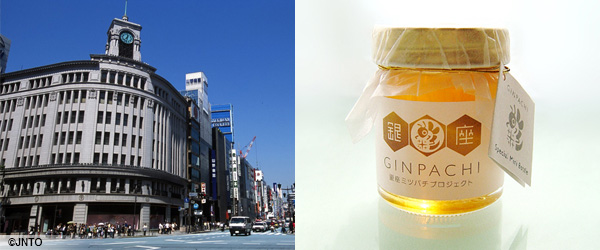
|
| Ginza is one of the most famous, high-end shopping districts in the world, lined with luxury brand shops, venerable long-established shops, nice department stores, and fancy restaurants. The area around the 4-chome crossing in the center of Ginza boasts the most expensive land price in Japan. Recently, one project in the district has been generating much buzz: Ginza Mitsubachi Project, or Ginza honeybee project. This is a beekeeping project on the rooftop of Kami-parupu Kaikan Building in Ginza 3-chome, a one-minute walk from Ginza 4-chome. The unique combination of Ginza and honeybees. How was it born? We asked Atsuo Tanaka, Deputy Vice-president of NPO Ginza Mitsubachi Project. |
| Reasons for Beekeeping in Ginza |
––When you actually tried starting up, how did things go?
It is said that honeybees can move within 3-4 square km (1.2-1.5 square miles) and Ginza has the Imperial Palace, Hibiya Park, and Hama-rikyu Gardens in the vicinity. Moreover, administrative district Kasumigaseki and Maronie-dori Street in Ginza are home to horse chestnut trees and Namiki-dori Street in Ginza is lined with many trees including lindens. We surprisingly found Ginza is a town of flowers. The quantity has been steadily increasing and we got 1,000 kg (2,205 lbs) of honey last year! |
| Products Made from Honey of Ginza |
As Ginza is a town where craftsmen have lived since the Edo period (1603-1867), we wanted to develop products using skills of Ginza. Now, local shops, such as Matsuya Department Store, Mikasa Kaikan, Shiseido Parlor, Ginza Bunmeido, and Henri Charpentier use the honey for making sweets and cakes, and Albion (major cosmetics maker in Ginza) uses it for cosmetics. Bars make cocktails using the honey and restaurants cook dishes with the honey. Sapporo Breweries experimented for two years and developed "Ginza Brown," a beer using a yeast carried by bees for the first time in the world. ––Does this mean you aren’t selling the honey itself but encouraging shops in Ginza to use the honey? With a few exceptions, "local production for local consumption" is the motto of our project. And basically we promote the idea that the honey of Ginza can be experienced only in Ginza. The taste of our honey changes week by week because the bees collect from different trees. The different taste of the honey epitomizes the fact that you are consuming and enjoying the seasonal environments of Ginza. Actually, buyers are making more efforts to create "Ginza Brand" goods using the honey than us, so in terms of this, Ginza Brand is "made in Ginza" created through collaborative activities of all of Ginza. |
| Ripple Effects of Beekeeping in Ginza |
We found an environmental change. About three years after the start of the project, cherry trees in the Imperial Palace and Hama-rikyu Gardens and horse chestnut trees in Kasumigaseki produced berries. The bees not only collect honey but also help pollination and bearing. Wild birds began to come. A virtuous cycle of the natural environment has been created. Local people also increased awareness of the environment and we started a making-roof-farm project called "Ginza Bee Garden" in 2007. This aims to promote greening of Ginza through planting flowers for the bees and planting edible plants on the roof of buildings in Ginza. More and more people have become in favor of the project, more and more companies cooperate to provide the roof, and we have 13 Bee Gardens in Ginza now. |
| Future Vision |
––What is your plan for future development?
Now we cultivate herbs on the roof farms. Following the honey, the fresh herbs are used for cocktails at bars in Ginza with which we have a good relation through the honey project. ––Is it possible to observe the beekeeping work and the roof farms? Not only media in Japan but overseas media have reported our activities in recent years, and a new tour to see the roof farm was launched this year. The honeybees usually collect honey from spring, around when cherry blossoms bloom, to August. But you can see the beekeeping place anytime throughout the year for 1,000 yen (USD 9) per person (tax included). Shops at which you can buy and experience products using the Ginza honey throughout the year Sweets using the honey are available at Matsuya Department Store http://www.matsuya.com/foreigner/en/m_ginza/ Food and drink items using the honey are available at Swan Cafe http://www.swanbakery.co.jp/shop2/ginza.html (Japanese version only) |
| Tokyo's Concept Cafe |
|
Bunbougu (Stationery) Cafe |
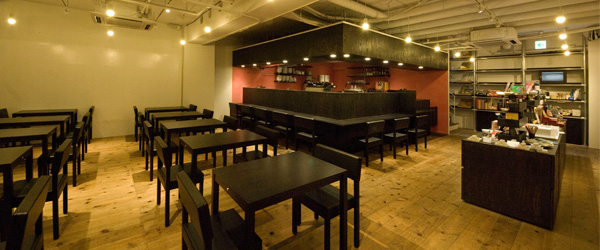 |
You can share your Tokyo experience on the spot via SNS, but Tokyo always offers some alternatives. It might sound a bit analog, yet fun—drawing is what we would like to recommend today.
The spot we would like to share with you is the Bunbougu Cafe— a short 3 to 4-minute walk from Omotesando Station. This cafe is situated on the first basement floor of the building that houses it. Patrons who descend the stairs are greeted with the visage of an open-kitchen cafe with a shop displaying a collection of stationery from around the world. Just looking at various stationery items unique to Japan is enjoyable, and people also can use many items freely. There are also stationery-related books and magazines to browse through. Some enjoy tea and a yummy meal while writing letters or sketching a picture, and others savor their coffee and carefully contemplate which stationery items they’d like to purchase and bring home as a gift. Electric outlets and free Wi-Fi are available at this concept cafe, but why not enjoy an analog moment while inspired by the surrounding creative atmosphere? |
| Website | http://www.bun-cafe.com/ (Japanese version only) |
|---|---|
| Address | B1F Uchida Bldg. 4-8-1 Jingumae, Shibuya-ku, Tokyo |
| Map | Map |
| Open | 10:00-23:30 (Food L.O. 22:30 / Drink L.O. 23:00) |
| Regular holiday | None |
| WiFi | Available; please ask staff for the SSID password |
|
Calbee+ HARAJUKU
|
|
| Website | https://www.calbee.co.jp/english/jp/ |
|---|---|
| Address | 1-16-8 Jingu-mae, Shibuya-ku, Tokyo (on Harajuku Takeshita-dori Street) |
| Map | Map |
| Access | About a 5 min walk from JR Harajuku Sta. and Tokyo Metro’s Meiji-Jingumae Sta. |
| Event Information |
|
Share Your Pics of the Illumination in Marunouchi via Free Wi-Fi!
[Marunouchi Illuminations 2014] |

|
|
Located west of Tokyo Station, the Marunouchi area has become a popular place in Japan with recent years seeing many of the latest commercial facilities built there. Marunouchi Illuminations is the main feature of the area from autumn to winter. Some 240 trees along Marunouchi Naka-dori Street for about 1.2 kilometers from Otemachi to Yurakucho are decorated with glittering champagne-colored LEDs. This year, 106 million LEDs will produce the most breathtaking view of Marunouchi.
At public areas in the Otemachi, Marunouchi, and Yurakucho areas, including the entrances of buildings, you can access the Internet by connecting to JAPAN FREE WIFI. This will allow you to freely upload photos you have taken of the illuminations at the site. It is not that far of a walk from the event area to Ginza. If you are tired after walking to Ginza, take a break at the bars featured in this issue, which serves drinks with local Ginza honey and herbs. |
| Website | http://www.marunouchi.com/e/shop?type=top |
|---|---|
| Map | http://www.marunouchi.com/e/page/map.html |
| Date | 17:00 – 23:00 (tbd) on November 13, 2014 – February 15, 2015, 17:00 – 24:00 in December (tbd). |
| JAPAN FREE WIFI | http://www.marunouchi.com/e/page/map_wifi.html |
|---|
|
List of events and festivals Go to our website & find more exciting events and festivals. |
| No Negative Impact on Our Health: Updated Radiation-related |
Radiation dose after touring Tokyo for one day (July 9, 2012) Report on field measurements
by Japan Tourism Agency Measurements results of Environmental radiation levels in Tokyo by Tokyo Metropolitan Institute of Public Health Information on the Great East Japan Earthquake by Ministry of Health, Labor and Welfare |
 |
To access the previous edition of e-Tokyo Today and our printed newsletter, Tokyo Today, please visit: e-Tokyo Today back number. If at any time you wish to stop receiving our emails, Please email to news@tcvb.or.jp. Issued by: Tourism Division, Bureau of Industrial and Labor Affairs, Tokyo Metropolitan Government Planning / Editing: Tokyo Convention & Visitors Bureau E-mail: news@tcvb.or.jp Tel: +81-3-5579-2683 Fax: +81-3-5579-2685 |
 |